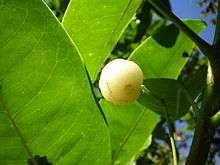Acronychia acidula
| Acronychia acidula | |
|---|---|
 | |
| Acronychia acidula, leaf and fruit, cultivated | |
| Scientific classification | |
| Kingdom: | Plantae |
| (unranked): | Angiosperms |
| (unranked): | Eudicots |
| (unranked): | Rosids |
| Order: | Sapindales |
| Family: | Rutaceae |
| Genus: | Acronychia |
| Species: | A. acidula |
| Binomial name | |
| Acronychia acidula F. Muell. | |
Acronychia acidula, lemon aspen, is a small- to medium-sized rainforest tree of the family Rutaceae native to north Queensland, Australia. The aromatic and acidic fruit is harvested as a bushfood.
Taxonomy
Victorian state botanist Ferdinand von Mueller described the lemon aspen in 1864.[1] Its species name acidula is Latin "slightly acid".[2]
Common names include lemon aspen, hard aspen and lemonwood.[1] The true aspens of the Northern Hemisphere belong to the genus Populus in the willow family Salicaceae.[3] The genus Acronychia is a member of the rue family Rutaceae, the same family as the genus Citrus which contains true lemons.
Ecology
The fruit are eaten by the topknot pigeon (Lopholaimus antarcticus).[4]
Uses
Lemon aspen fruit has a grapefruit and lime-like flavor, and is popular in beverages, sauces and confectionery. The fruit has high antioxidant activity.[5]
Cultivation
The tree is grown in small-scale commercial bushfood orchards on the east coast of Australia from North Queensland to northern New South Wales. The tree is quick-growing and requires regular pruning to maintain a practical harvesting height. It has a moderate crop yield, and bears in four years from seedlings. It prefers well-drained and fertile clay loam soils, with a sunny aspect and extra moisture when young.[2]
References
- 1 2 Hyland, B. P. M.; Whiffin, T.; Zich, F. A.; et al. (Dec 2010). "Factsheet – Acronychia acidula". Australian Tropical Rainforest Plants. Edition 6.1, online version [RFK 6.1]. Cairns, Australia: Commonwealth Scientific and Industrial Research Organisation (CSIRO), through its Division of Plant Industry; the Centre for Australian National Biodiversity Research; the Australian Tropical Herbarium, James Cook University. Retrieved 15 March 2013.
- 1 2 Elliot, Rodger W.; Jones, David L.; Blake, Trevor (1982). "A-Ca". Encyclopaedia of Australian Plants suitable for cultivation. 2. Port Melbourne, Victoria: Lothian Publishing. p. 141. ISBN 0-85091-143-5.
- ↑ "technology transfer fact sheet: Populus spp." (PDF). Forest Products Laboratory: R&D USDA. Madison, Wisconsin: United States Department of Agriculture Forest Service. Retrieved 20 September 2010.
- ↑ Barker, RD; Vestjens, WJM (1984). The Food of Australian Birds: (I) Non-passerines. Melbourne University Press. p. 301. ISBN 0-643-05007-8.
- ↑ Zhao, J., Agboola, S., Functional Properties of Australian Bushfoods - A Report for the Rural Industries Research and Development Corporation, 2007, RIRDC Publication No 07/030
- Bruneteau, Jean-Paul, Tukka, Real Australian Food, ISBN 0-207-18966-8.
- Kersh, Jennice and Raymond, Edna's Table, ISBN 0-7336-0539-7.
- Low, Tim, Wild Food Plants of Australia, ISBN 0-207-16930-6